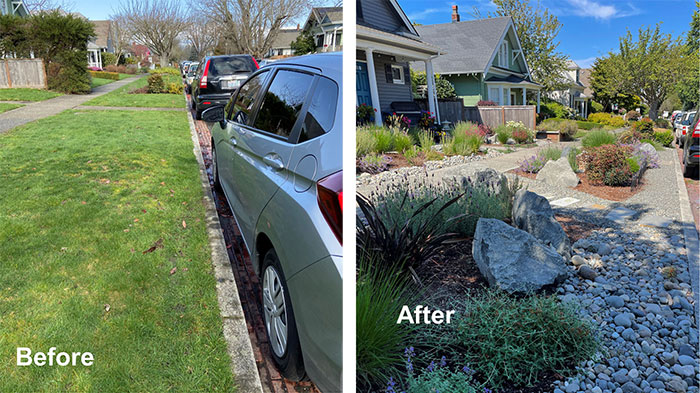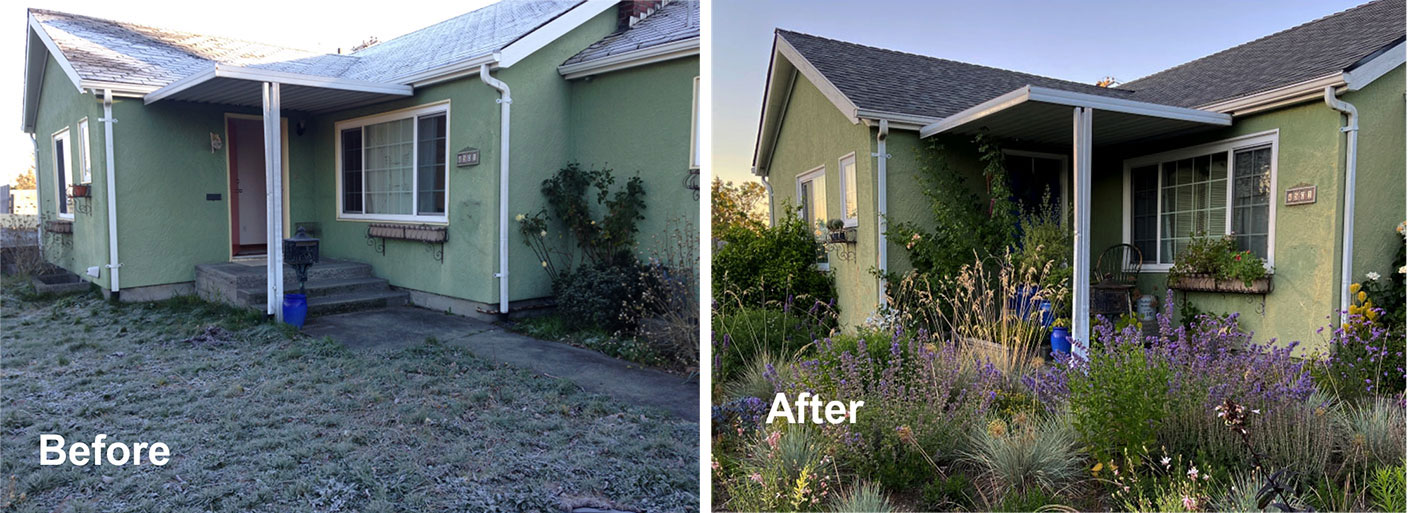Sue Goetz CPH, ecoPRO
APLDWA, past President
First to note: this is not a deep dive "how-to" article. It is more about sparking discussion of naturalistic gardens from a designer's point of view. As the style becomes more mainstream, I have seen an uptick in clients asking for naturalistic gardens, native plant gardens, lawn removal, low maintenance, and low water use.

A complete lawn removal for a client in Tacoma incorporating natural rockery, perennials, ornamental grasses, and shrubs. All photos by Sue Goetz.
Let's talk about the new naturalism- the evolution from over-manicured, chemical-laden lawns and gardens to green spaces with a more natural approach. Is it for every space? How do we design them for longevity and sustainability once they are in the client's hands to take care of? It starts with your plant knowledge, experiences, and learning from other designers. When looking for information, I look to designers (particularly in the UK and Germany) not only for their knowledge and plant layouts but also for sustainability- how are these types of projects doing? I find conversations with city entities and homeowners to be on the side traditional- "We don't want it to look messy, dead all winter, or high maintenance." It is our job as designers to communicate what naturalistic means. I prefer to term it "low input" instead of low maintenance. Create a successful design plan that, from the beginning, uses elements that need not be overly maintained to keep the landscape looking good.

The Lurie Garden in Chicago. Public spaces have built-in challenges, and I watch and read about the sustainability of these projects over the years to help in my design work.
Plants Going Natural
Naturalistic design is not plants going feral or free-range; it still has sound design principles of "unity, harmony, and repetition." It also forces designers to be better ecologists; we are evolving based on what the climate is doing. Clients are paying attention to all the buzz of climate change, chemical use, etc., and the effects on their gardens. We need to let them know a designer can help them with solutions. Garden designers are at the forefront of eco-garden design, but we need to understand ecology better to succeed in that business. We are choosing all types of plants that survive and still look decent in changing seasons, including summer, when low water use is in effect. You might have to abandon plants you typically use and choose plants that perform well even when they're not at their best.
When a client asks for native plants, you can't just pick a native plant, put it in a bark-laden, irrigated traditional landscape, and expect it to behave as it does in the wild. Native plants are not necessarily self-sufficient because you put them in a design. They are more self-sufficient because you put them in an environment similar to where they naturally occur. It is short-sighted to put them in an urban site without also looking at the cultural conditions you're designing in. Talk to clients about using native plants, not just because they are native, but because they add a greater purpose to the designed space.

Landscape restoration in Federal Way, Washington. This project created a woodland space for the homeowner to plant more Pacific Northwest Natives where they would thrive.
People are becoming more inspired by plants designed in unforced ways and the use of native plants. We must consider where they do well and how to cultivate them best. Curate plants and design lines to look natural- not manipulated. I find that very few gardens are initially ready for a natural design; they have been stripped of plants, trees, and good soil. We must truly evaluate the existing conditions and see what we need to design to make them work. Design the space (pathway, patios, etc.) to meet the client's needs. Plants are the given and the support system for the environment. Consider plants from the perspective of their maintenance, their sustainability, and their purpose to the environment. It is the rhythm and movement of repeated plants, not a broad variety plant palette. Some gardens can be helped by just simplifying and restraint. Don't get me wrong, plant diversity is a good thing. It is not about a single plant but a combination and the ability to pick a plant palette that might not be very glamorous. Choose tried and true, tough plants and design them in an interesting way.

My "front lawn" is a muse to learn what works and what doesn't to help with design ideas. I removed the lawn and used evergreen shrubs, ornamental grasses, and perennials for all seasons.
The HOA Conversation
Eco-design and getting the confidence of HOAs (Homeowners Associations)
As designers of eco-friendly landscapes, there is a language shift in how we talk to clients, HOAs, and even contractors installing our work. HOAs want their rules followed, and naturalistic is a dirty word to some. Is there room for diverse landscapes in a sea of traditional manicured lawns? Every circumstance is different. But it has to start somewhere, and it is conversation. Homeowners Associations often have specific guidelines for landscaping to maintain a uniform look in the neighborhood. It sometimes conflicts with the desire for more natural or eco-friendly gardens, prioritizing native plants, biodiversity, and sustainability. Here are a few strategies to consider.
-
Communication and Education:
Talk to the client and HOA about the benefits of natural garden designs, such as reduced water usage, increased biodiversity, and support for local wildlife and the environment. - Compromise:
Try to incorporate elements of both styles. For example, a manicured front yard that meets HOA standards and a more natural backyard or other green spaces around the houses. - Demonstrate Benefits:
Build a portfolio of both photos and knowledge to provide examples of successful natural gardens and how they meet or exceed HOA standards for aesthetics and maintenance. - Propose Changes:
Work with the HOA to update the landscaping guidelines to be more inclusive of sustainable practices. - Research Local Regulations:
Understand HOA's guidelines and local environmental regulations. You are not battling against them; you are on the same team. - Create a Design Plan:
Develop a detailed garden design that balances natural elements with HOA requirements. - Seek Approval:
Present your design to the HOA for approval, emphasizing the plan's compliance with their rules and the benefits of naturalism you have added in. - Baby Steps:
Start with small changes and expand as you establish the garden's success.
